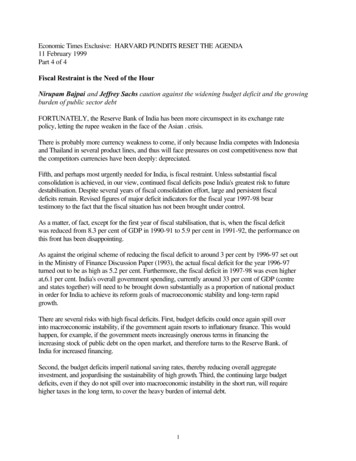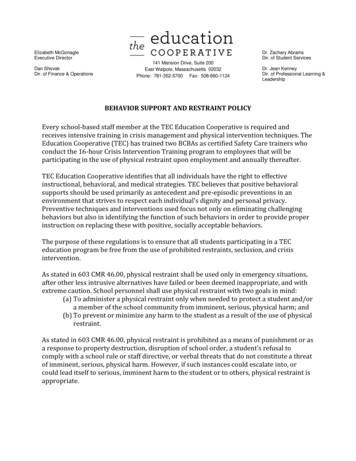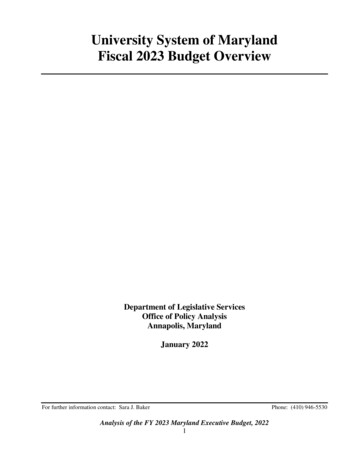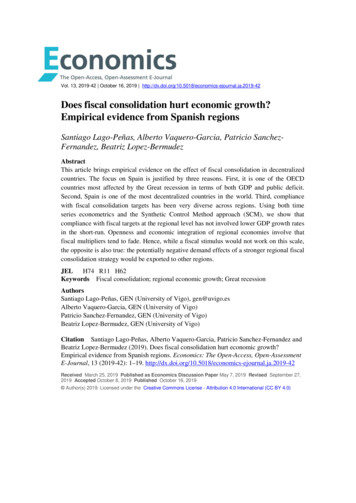
Transcription
Economic Times Exclusive: HARVARD PUNDITS RESET THE AGENDA11 February 1999Part 4 of 4Fiscal Restraint is the Need of the HourNirupam Bajpai and Jeffrey Sachs caution against the widening budget deficit and the growingburden of public sector debtFORTUNATELY, the Reserve Bank of India has been more circumspect in its exchange ratepolicy, letting the rupee weaken in the face of the Asian . crisis.There is probably more currency weakness to come, if only because India competes with Indonesiaand Thailand in several product lines, and thus will face pressures on cost competitiveness now thatthe competitors currencies have been deeply: depreciated.Fifth, and perhaps most urgently needed for India, is fiscal restraint. Unless substantial fiscalconsolidation is achieved, in our view, continued fiscal deficits pose India's greatest risk to futuredestabilisation. Despite several years of fiscal consolidation effort, large and persistent fiscaldeficits remain. Revised figures of major deficit indicators for the fiscal year 1997-98 beartestimony to the fact that the fiscal situation has not been brought under control.As a matter, of fact, except for the first year of fiscal stabilisation, that is, when the fiscal deficitwas reduced from 8.3 per cent of GDP in 1990-91 to 5.9 per cent in 1991-92, the performance onthis front has been disappointing.As against the original scheme of reducing the fiscal deficit to around 3 per cent by 1996-97 set outin the Ministry of Finance Discussion Paper (1993), the actual fiscal deficit for the year 1996-97turned out to be as high as 5.2 per cent. Furthermore, the fiscal deficit in 1997-98 was even higherat,6.1 per cent. India's overall government spending, currently around 33 per cent of GDP (centreand states together) will need to be brought down substantially as a proportion of national productin order for India to achieve its reform goals of macroeconomic stability and long-term rapidgrowth.There are several risks with high fiscal deficits. First, budget deficits could once again spill overinto macroeconomic instability, if the government again resorts to inflationary finance. This wouldhappen, for example, if the government meets increasingly onerous terms in financing theincreasing stock of public debt on the open market, and therefore turns to the Reserve Bank. ofIndia for increased financing.Second, the budget deficits imperil national saving rates, thereby reducing overall aggregateinvestment, and jeopardising the sustainability of high growth. Third, the continuing large budgetdeficits, even if they do not spill over into macroeconomic instability in the short run, will requirehigher taxes in the long term, to cover the heavy burden of internal debt.1
High tax rates will place India at a significant disadvantage relative to other fast-growing countries.We believe that deficits should be brought under control mainly. by cutting governmentexpenditures relative to GDP rather than by raising revenues relative to GDP.Moreover, there is probably little room to reduce capital expenditure, which have already beensqueezed to a mere 3.7 per cent of GDP in 1997-98. Hence, it is the current expenditure whichneeds to be reduced significantly. Current expenditures at the central level are predominantly madeup of interest payments, grants to states, subsidies, and defence expenditureIn the latter three areas, there. have been some reductions in spending relative to GDP. Grants tostates have declined from 2.5 per cent of GDP in 1990-91 to 2 per cent of GDP in 1997-98; explicitcentral government subsidies have been reduced from 2.3 per cent of GDP to 1.4 per cent of GDP,and defence expenditure has declined from 2 per cent of GDP to 1.9 per cent of GDP. Interestpayments, of course, have risen not declined, but have risen from 4 per cent of GDP in 1991 to 4.6per cent of. GDP in 1997-98. Further progress is needed in reductions in most of the main areas ofcurrent spending.With respect to internal public debt, there is one mechanism that could substantially ameliorate thefiscal situation. Privatisation of public enterprises could raise significant funds as a percentage ofGDP, which could then be used to buy down the public debt.Not only, would the stock of debt itself be reduced, but also the interest costs of servicing the debtwould surely decline as the debt stock itself was brought under control.The cash value of these enterprises vastly exceeds the present value of profit flows that the statenow collects on these assets. Public sector profits are dissipated in poor productivity, overmanning, excessive public sector salaries, soft budget constraints, and generally poor public-sectormanagement.For this reason, sales of the enterprises to private sector buyers, if used to buy down the publicdebt, would yield annual saving in interest costs that most likely would far exceed the government .revenues that are claimed by virtue of state ownership of assets. (This is especially true in view ofthe fact that many enterprises with significant positive market value are actually loss makers incurrent cash flow, under state management).A substantial amount of interest savings on India's internal debt could be generated if thegovernment were to undertake an extensive privatisation of the central public sector enterprises.According to the Economic Survey, 1996-97, at least 25 per cent of the outstanding marketabledebt (largely made up of market loans, special bearer bonds, and 91/182-day treasury bills) couldbe retired by selling the economic assets of the government.However, this estimate is based on the book value of the assets, and consequently it would be muchhigher when converted into current value. Besides, the sale of these assets could retire more of thetotal liabilities depending upon the mode and timing of such sale. The central government currentlyhas equity holdings in 240 enterprises, 27 banks, and two large insurance companies. Further2
spending cuts could come from liquidation of loss-making enterprises that have no positive netmarket value.There were 104 loss-making enterprises in 1992 accounting for a total loss of Rs 39.5 billion.Liquidation of these would imply a rise in domestic savings and, of course, these savings would behigher if there is salvage value in part or all of some of these enterprises. To capture these savingswould require implementation of an exit policy to allow the' government to close down these lossmaking enterprises. Reduction in central government subsidies (both explicit and implicit) isanother area of expenditure control. While central government explicit subsidies have declinedfrom a total of 2.3 per cent of GDP in 1990-91 to 1.4 percent of GDP in 1997-1998 there still isroom to reduce these further, especially. those that do not benefit the poor.The explicit subsidy bill of the central government is almost entirely made up of fertiliser and foodsubsidy.Fertiliser subsidy, for instance, could be phased out over the medium term, and simultaneouslyduring this period the government could undertake a well targeted, and time-limited programme forcompensating the poor farmers for their loss of income.The food subsidy bill also needs to be reduced with the exclusion of the non-poor from access tothe public distribution system. In the case of the central government there has been notableprogress with regard to tax reforms, but almost nothing in the area of expenditure reform.At the state level, both tax and expenditure reforms have a long way to go as we discuss thembelow. Like the central government, the financial, condition of the state governments in India hasalso been a cause for concern.Over the years, the consolidated financial position of the state governments has shown a markeddeterioration in some of their major deficit indicators. One of the fundamental weaknesses of state.government finances in India can be attributed to the increases in non-developmental expenditure,particularly the revenue component of the non-developmental expenditure, and interest paymentsas a proportion of revenue receipts.These problems have been aggravated a great deal over the past few years because of a variety ofreasons. The resource constraints in state finances have been accentuated by a near stagnant taxGDP ratio, rising share of non-developmental outlay in the total expenditure, large volumes ofhidden or implicit subsidies and, increasing financial losses of state enterprises. A growing pressureon state finances has also stemmed from the rising demand for public services. Furthermore, thefiscal situation in the states is likely to come under much greater pressure with the acceptance of.the report of the Fifth Pay Commission by several state governments in India. The slow growth inrevenue mobilisation at the state level has posed serious difficulties for the state governments tomeet their expenditures.Be that as it may, the critical problem in state finances is not only one of high levels of expenditure,but also one of increasing distortions in the pattern of expenditure. Further progress in the area oftax and expenditure reform is as crucial for the states as it is for the Centre. State governments are3
required to reduce and eventually do away with subsidies on power, transportation, and irrigationso as to reduce the burden on state budgets. Importantly enough, state governments have to find away to reduce their expenditure on wages and salaries of their employees.The state expenditure on administrative services is budgeted to rise by 44.3 per cent on account ofthe revision of pay scales of government employees following the Fifth Pay Commission awards.According to estimates of a study by the Planning Commission, should all the state governmentsraise the salaries of their employees in line with the Fifth Pay Commission, then the states will haveto pay out an additional Rs 1,000. billion as salaries and wages over the next five years.The Planning Commission estimates also include higher salaries for quasi government employees,including staff of public sector undertakings (PSUs) and local bodies. The state governments wagebill, even without the Fifth Pay Commission .awards, is the single biggest expenditure item foralmost all state governments. On an average, all state governments, spend around 60 paise of everyrupee earned as revenue on wages and salaries. In particular, states like Maharashtra (with 2.2million employees), Andhra Pradesh (1.1 million employees), West Bengal (950,000 employees),Gujarat (620,000 employees),.and Kerala (520,000' employees) are likely to be the hit hard withthese awards. Expenditure adjustment at the state level should take into account its implications forthe critical sectors such as social services.A significant portion of the expenditure on social services comes under the purview of the stategovernments, because of the federal set-up of the constitution, which places the responsibility ofundertaking human resource development primarily on the state government. The social serviceexpenditure of the state governments as a percentage to GDP showed a rising trend during the1980s, from 4.8 per cent of GDP in 1980-81 to 5.6 per cent in 1990-91. In the first half of 1990s,however, there was a decline in the ratio owing to the resource crunch faced by a number of states.It came down to 5.3 per cent in 1992-93 and further to 5.1 percent in 1994-95 and remainedthereafter in the range of 5.1 to 5.5 per cent.A shift of .policy focus towards changing the. pattern of resource allocation and improving theresource base of states is critical for improving the financial situation of the state governments. Onthe tax, front, sales tax is the single mot revenue earning source for the state governments, and itsreform, is crucial so as to attain higher levels of revenue mobilisation.While efforts to introduce state level VAT and other tax reform measures have begun, theirimplementation across X11 states is necessary in order to enhance the revenue productivity of thestag tax system arid, to reduce its distortionary implications for the economy. In the final analysis,fiscal control will require an overhaul not just in budgetary patterns, but in the basic functioning ofthe public sector in the economy. For example, we have noted that privatisation is a key method forreducing the over hang of public debt. Similarly, the privatisation of infrastructure services is a keyway to relieve the growing burden on state budgets, which are heavily weighed down by losses ofSEBs and other parastatal institutions.Greater autonomy for local and state-level governments in infrastructure reform and investmentpriorities will similarly allow the central government greater freedom in cutting back on transferpayments to the states (which will be in a better position to prioritise and economise on state4
spending). , Until India resolves to, push even farther in market reforms, the soft budget constraintof the public sector will continue to spill over into large public deficits and a growing burden ofpublic sector debt.5
Fifth, and perhaps most urgently needed for India, is fiscal restraint. Unless substantial fiscal consolidation is achieved, in our view, continued fiscal deficits pose India's greatest risk to future destabilisation. Despite several years of fiscal consolidation effort, large and persistent fiscal deficits remain.










